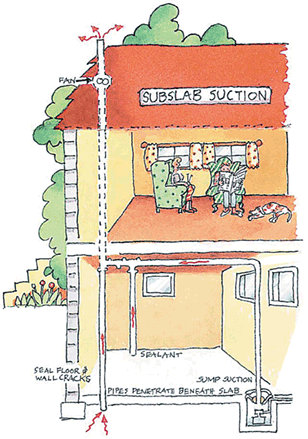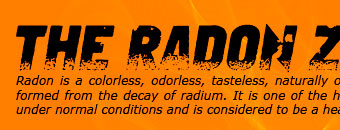5. How can I get reliable radon test results?
Radon testing is easy and the only way to find out if you have a radon problem in your home.
a. Types of Radon Devices
Since you cannot see or smell radon, special equipment is needed to detect it. You can hire a qualified radon tester, who will use a radon device(s) suitable to your situation. The most common types of radon testing devices are listed below.

Passive Devices
Passive radon testing devices do not need power to function. These include charcoal canisters, alpha-track detectors, charcoal liquid scintillation devices, and electret ion chamber detectors. These devices are exposed to the air in the home for a specified period of time and then sent to a laboratory for analysis. Both short-term and long-term passive devices are generally inexpensive. Some of these devices may have features that offer more resistance to test interference or disturbance than other passive devices. Qualified radon testers may use any of these devices to measure the home’s radon level.
Active Devices
Active radon testing devices require power to function. These include continuous radon monitors and continuous working level monitors. They continuously measure and record the amount of radon or its decay products in the air. Many of these devices provide a report of this information which can reveal any unusual or abnormal swings in the radon level during the test period. A qualified tester can explain this report to you. In addition, some of these devices are specifically designed to deter and detect test interference. Some technically advanced active devices offer anti-interference features. Although these tests may cost more, they may ensure a more reliable result.
b. General Information for All Devices
Make sure to use a radon measurement device from a qualified laboratory. Certain precautions should be followed to avoid interference during the test period; see the Radon Testing Checklist for more information on how to get a reliable test result.
Radon Test Device Placement
EPA recommends that testing device(s) be placed in the lowest level of the home suitable for occupancy. This means testing in the lowest level (such as a basement), which a buyer could use for living space without renovations. The test should be conducted in a room to be used regularly (such as a family room, living room, playroom, den, or bedroom); do not test in a kitchen, bathroom, laundry room or hallway. Usually the buyer decides where to locate the radon test, based on their expected use of the home. A buyer and seller should explicitly discuss and agree on the test location to avoid any misunderstanding. Their decision should be clearly communicated to the person performing the test.
c. Preventing or Detecting Test Interference
There is a potential for test interference in real estate transactions. There are several ways to prevent or detect test interference:
• Use a test device that frequently records radon or decay product levels to detect unusual swings;
• Employ a motion detector to determine whether the test device has been moved or if testing conditions have changed;
• Use a proximity detector to reveal the presence of people in the room which may correlate to possible changes in radon levels during the test;
• Record the barometric pressure to identify weather conditions which may have affected the test;
• Record the temperature to help assess whether doors and windows have been opened;
• Apply tamper-proof seals to windows to ensure closed-house conditions; and
• Have the seller/occupant sign a non-interference agreement.
Home buyers and sellers should consult a qualified radon test provider about the use of these precautions.
d. Length of Time to Test
Because radon levels tend to vary from day to day and season to season, a short-term test is less likely than a long-term test to tell you your year-round average radon level. However, if you need results quickly, a short-term test may be used to decide whether to fix the home.
There Are Two General Ways to Test Your Home for Radon:
Short-Term Testing
The quickest way to test is with short-term tests. Short-term tests remain in your home from two to 90 days, depending on the device. There are two groups of devices which are more commonly used for short-term testing. The passive device group includes alpha track detectors, charcoal canisters, charcoal liquid scintillation detectors, and electret ion chambers. The active device group consists of different types of continuous monitors.
Long-Term Testing
Long-term tests remain in your home for more than 90 days. Alpha track and electret ion chamber detectors are commonly used for this type of testing. A long-term test result is more likely to tell you your home’s year-round average radon level than a short-term test. If time permits (more than 90 days), long-term tests can be used to confirm initial short-term results. When long-term test results are 4 pCi/L or higher, EPA recommends fixing the home.
Whether you test for radon yourself or hire a qualified tester, all radon tests should be taken for a minimum of 48 hours. Some devices require a longer (minimum) length of time, e.g., a 7-day charcoal canister device.
e. Doing a Short-Term Test...
If you are testing in a real estate transaction and you need results quickly, any of the following three options for short-term tests are acceptable in determining whether the home should be fixed. Any real estate test for radon should include steps to prevent or detect interference with the test device.
Short-Term Testing Options
Passive:
Take two short-term tests at the same time in the same location for at least 48 hours.
or; take an initial short-term test for at least 48 hours. Immediately upon completing the first test, do a second test using an identical device in the same location as the first test.
Active:
Test the home with a continuous monitor for at least 48 hours.
What to Do Next
• Fix the home if the average of the two tests is 4 pCi/L or more.
• Fix the home if the average radon level is 4 pCi/L or more.
f. Using Testing Devices Properly for Reliable Results
When you are taking a short-term test, close windows and doors to the outside and keep them closed, except for normal entry and exit. If you are taking a short-term test lasting less than four days, be sure to:
• Close your windows and outside doors at least 12 hours before beginning the test;
• Do not conduct short-term tests lasting less than four days during severe storms or periods of high winds;
• Follow the testing instructions and record the start time and date;
• Place the test device at least 20 inches above the floor in a location where it will not be disturbed and where it will be away from drafts, high heat, high humidity, and exterior walls;
• Leave the test kit in place for as long as the test instructions say; and
• Once the test is finished, record the stop time and date.
If You Hire a Qualified Radon Tester
In many cases, home buyers and sellers may decide to have the radon test done by a qualified radon tester who knows the proper conditions, test devices, and guidelines for obtaining a reliable radon test result. They can also:
• Evaluate the home and recommend a testing approach designed to make sure you get reliable results;
• Explain how proper conditions can be maintained during the radon test;
• Emphasize to a home’s occupants that a reliable test result depends upon their cooperation. • Interference with, or disturbance of, the test or closed-house conditions will invalidate the test result;
• Analyze the data and report the measurement results; and
• Provide an independent test result.

g. Interpreting Radon Test Results
The average indoor radon level is estimated to be about 1.3 pCi/L; roughly 0.4 pCi/L of radon is normally found in the outside air. The U.S. Congress has set a long-term goal that indoor radon levels be no more than outdoor levels. While this goal is not yet technologically achievable for all homes, radon levels in many homes can be reduced to 2 pCi/L or less.
Radon Test Results Reported in Two Ways
Your radon test results may be reported in either picocuries per liter of air (pCi/L) or working levels (WL). If your test result is in pCi/L, EPA recommends you fix your home if the radon level is 4 pCi/L or higher. If the test result is in WL, EPA recommends you fix the home if the working level is 0.02 WL or higher. Some states require WL results to be converted to pCi/L to minimize confusion.





